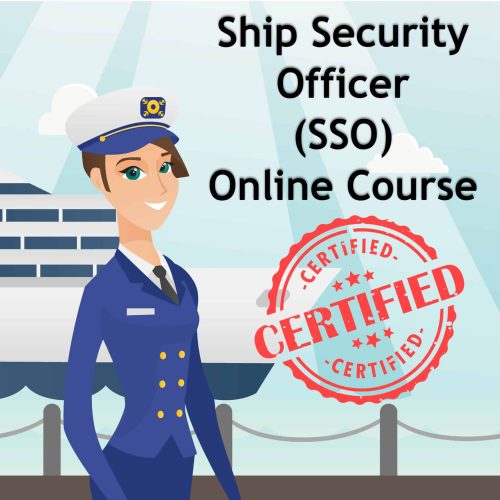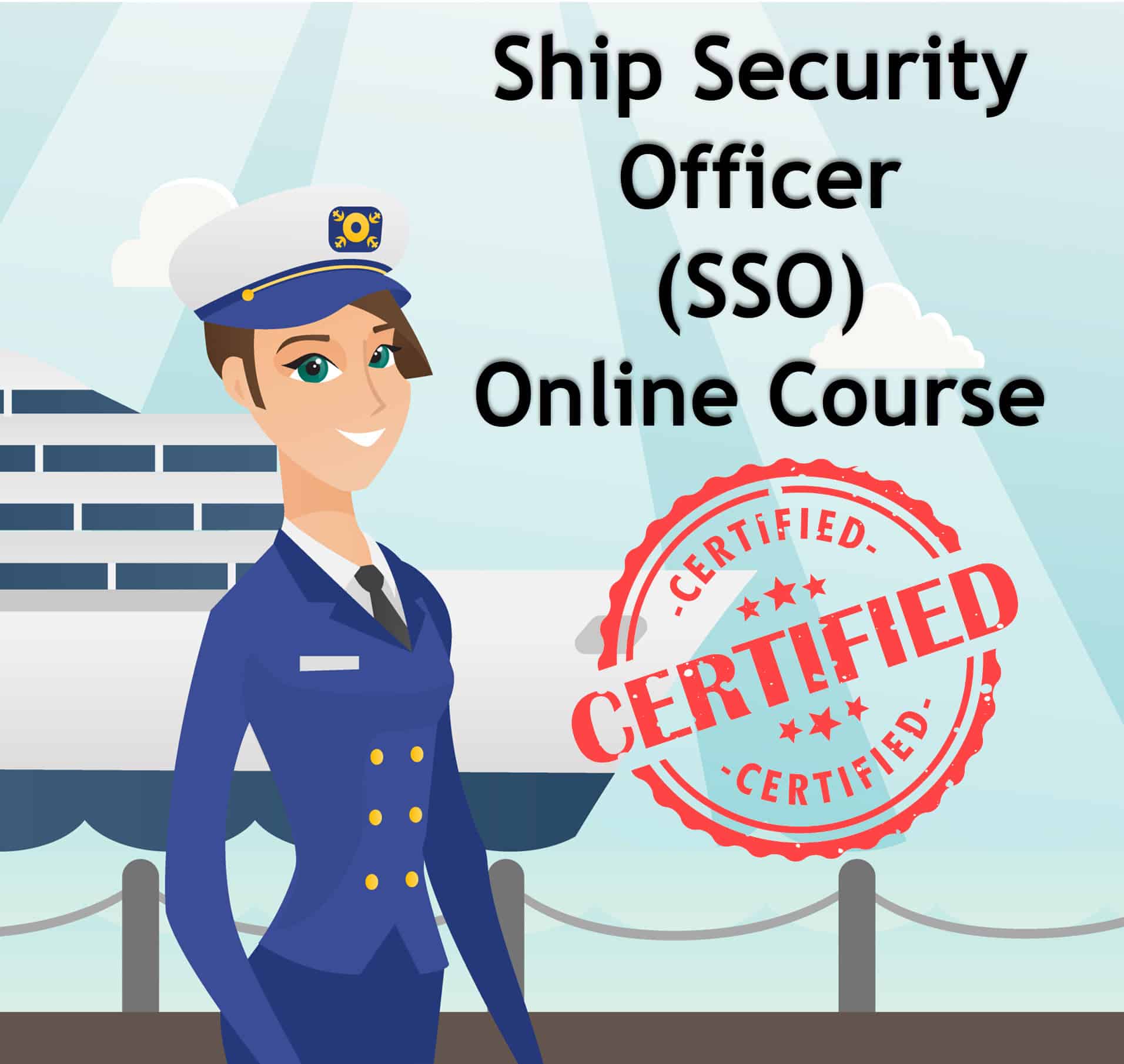Agent de sûreté de navire (SSO)

!Cette formation est actuellement disponible uniquement en anglais!
Ce cours en ligne offre la formation indispensable aux personnes désignées pour assumer les fonctions d’Officier de Sûreté du Navire (SSO). Il couvre l'ensemble des sujets requis par les directives de Transports Canada et les normes du Code ISPS, et est essentiel pour garantir que ceux qui occupent le rôle d’SSO comprennent parfaitement leurs devoirs et responsabilités.
Renseignement
Obtenez votre certificat SSO dès aujourd'hui
Formation Approuvés:
Virtual Maritime Academy est une institution reconnue par Transports Canada. Ce cours est entièrement approuvé et certifié par Transports Canada. Le certificat de formation de Transports Canada est reconnu et accepté à l'international conformément à la convention STCW, y compris par le MCA, l'USCG, l'AMSA, pour n'en nommer que quelques-uns…
Cette formation est destiné à:
Pour les officiers recherchant un certificat d'Officier de Sûreté du Navire (SSO).
Qualification du Cours:
Règlement VI/5, paragraphe 1 et Section A-VI/5, paragraphes 1 à 4 de la Convention et du Code STCW de 1978, telle que modifiée.
Prérequis:
L'étudiant doit avoir :
- 12 mois de temps de mer ou:
- À la discrétion de Transports Canada – un temps de mer approprié.
- A CDN Number from Transport Canada*
*Pour la certification de Transports Canada.
Réglementations, Code, Convention Abordés:
Le Code International pour la Sûreté des Navires et des Installations Portuaires (ISPS), Tableau STCW A-VI/5.
Objectifs du cours:
- Effectuer des inspections régulières de sûreté du navire afin de s'assurer que les mesures de sûreté appropriées sont maintenues ;
- Maintenir et superviser la mise en œuvre du Plan de Sûreté du Navire, y compris toute modification apportée au plan ;
- Coordonner les aspects de sûreté des passagers et/ou la gestion de la cargaison et des provisions du navire avec les autres membres de l’équipage et les Officiers de Sûreté des Installations Portuaires concernés ;
- Proposer des modifications au Plan de Sûreté du Navire ;
- Rapporter à l'Officier de Sûreté de la Compagnie toute déficience ou non-conformité identifiée lors des audits internes, des examens périodiques, des inspections de sûreté et des vérifications de conformité, et mettre en œuvre les actions correctives nécessaires ;
- Renforcer la sensibilisation et la vigilance en matière de sûreté à bord ;
- Veiller à ce qu'une formation adéquate soit fournie au personnel de bord, le cas échéant ;
- Rapporter tous les incidents de sûreté ;
- Coordonner la mise en œuvre du Plan de Sûreté du Navire avec l'Officier de Sûreté de l'Entreprise et l'Officier de Sûreté des Installations Portuaires concerné ;
- S'assurer que l'équipement de sûreté, s’il y en a, est correctement utilisé, testé, calibré et entretenu.
Structure du Cours:
Le cours SSO comprend :
- 10 chapitres;
- Des questions de confirmation après chaque chapitre;
- Un manuel de cours;
- Un examen finale du cours.
Examen Final
Il y a des questions à choix multiples à compléter à la fin de chaque chapitre ainsi qu'une évaluation finale. La note de passage est de 70 %. L'évaluation finale se déroule entièrement en ligne, sans besoin de se rendre en classe. Un surveillant vous sera assigné pour vous encadrer pendant l’évaluation finale. Vous aurez besoin d'un ordinateurpas une tablette ou Chromebook with a webcam and an ok internet speed for your Final Assessment. If for any reason you do not pass with a mark of at least 70% your Final Assessment there is a fee a 75$ + applicable taxes to re-attempt the Final Assessment.
Exigences Équipement pour l'Examen Finale
- Appareil: Un ordinateur de bureau ou un ordinateur portable est requis, équipé d'une webcam et d’un microphone. L’examen finale n’est pas compatible avec les tablettes, téléphones portables ou Chromebooks.
- Système d’exploitation: Windows 10 ou version ultérieure, Mac OS X 11 ou version ultérieure
- Navigateur Web: Google Chrome version 39 ou ultérieure, ou Mozilla Firefox version 34 ou ultérieure
- Connexion Internet: Vitesse minimale de 3 Mbps en téléchargement et en téléversement
- Matériel: 8 Go de RAM ou plus, microphone et haut-parleurs, webcam
Duré:
Environ 21 heures.
Vous pouvez entrer et sortir de ce cours aussi souvent que nécessaire.
Mode de Dispensation:
Le cours est 100 % en ligne, sans obligation de passer un test en salle de classe.
Exigences de Vérification des Étudiants:
Chaque étudiant doit soumettre une pièce d'identité officielle avec photo avant de commencer le cours. Il s'agit d'une exigence de Transports Canada.
Certification:
Le cours SSO est entièrement approuvé par Transports Canada et est reconnu à l’international. Il intègre les cours de Personnel du bâtiment ayant des responsabilités en matière de sûreté (VPWSR) PDSD et de Personnel du bâtiment n’ayant pas des responsabilités en matière de sûreté - (VPWOSR) (PSA), tels que définis dans la Règlementation VI/6 et la Section A-VI/6 de la Convention et du Code STCW.
Certificat:
La copie original sera envoyée gratuitement à votre adresse.
Sujets du Cours:
Un cours répondant à toutes les exigences.
- Politique de Sûreté Maritime
- Responsabilités en Matière de Sûreté
- Responsabilités en Matière de Sûreté
- Évaluation de la Sûreté du Navire
- Équipement de Sûreté
- Maintien de la sûreté de l'interface navire/port
- Plan de Sûreté du Navire
- Conventions, codes et recommandations internationaux
- Identification, Reconnaissance et Réponse aux Menaces
- Actions de Sûreté du Navire
- Méthodes de fouille physique et inspections non intrusives
- Préparation aux Urgences, Exercices et Entraînements
- Organisations de Sûreté Reconnues
- Législation et règlements gouvernementaux
- Administration de la Sûreté
- Méthodologie d'Évaluation des Risques
- Planification de Contingence
- Formation en Sûreté
- Équipements et systèmes de sûreté
- Audits et inspections de sûreté
- Et la liste peut continuer……
- Téléchargez le syllabus officiel du cours ICI
Obtenez votre certificat SSO dès aujourd'hui
Progression
Leçons
-
Introduction à l'Académie
- Introduction à l'Académie
- À Propos du Cours SSO
- L'examen Final
- Certification
- Notes de Cours
- Avis Important
- Vérification de l'Étudiant
- Formulaire d'Identité de l'Étudiant
- Commençons!
-
Introduction au Cours
- Historique
- Menaces de sûreté actuelles
- Common Security Threats Video
-
Chapitre 1 – Politique de Sûreté Maritime
- International Conventions, Codes
- Government Legislations & Regulations
- Définitions
- Legal & SSRI
-
Chapitre 2 – Responsabilités en Matière de Sûreté
- Gouvernements
- Security Personnel
-
Chapitre 3 – Évaluation de la Sûreté du Navire
- Évaluation des risques
- Outils d’évaluation
- On-Scene Security Surveys
- Security Assessment Documentation
-
Chapitre 4 – Équipement de Sûreté
- Équipement de Sûreté
- Limitations & Calibration
-
Chapitre 5 – Plan de Sûreté du Navire
- Purpose of the SSP
- Contents of the SSP
- Confidentiality Issues
- Implementation of the SSP
- Modification of the SSP
-
Chapitre 6 – Identification des Menaces
- Recognition & Detection of Weapons
- Methods of Physical Searches
- Implementing & Coordinating Searches
- Persons Posing Potential Security Risks
- Techniques to Circumvent Security Measures
- Crowd Management Techniques
-
Chapitre 7 – Actions de Sûreté du Navire
- Actions Required by Different Security Levels
- Maintaining Security
- Déclaration de sûreté (DoS)
- Reporting Security Incidents
- Implementation of Security Procedures
-
Chapitre 8 – Préparation aux Urgences
- Planification de Contingence
- Security Drills & Exercises Assessment
-
Chapitre 9 – Administration de la Sûreté
- Documentation & Records
- Monitoring & Control
- Security Audits & Inspections
- Reporting Non-Conformities
-
Chapitre 10 – Formation en Sûreté
- Exigences en matière de formation
- Techniques
-
L'examen Final
- Vérification Finale
- L'examen Final
- Demande de l'Examen
- Vos Commentaires
- Quelle est la Suite?
-
Certificat
- Certificat
- Merci!
- Ouvrir · Fermer






